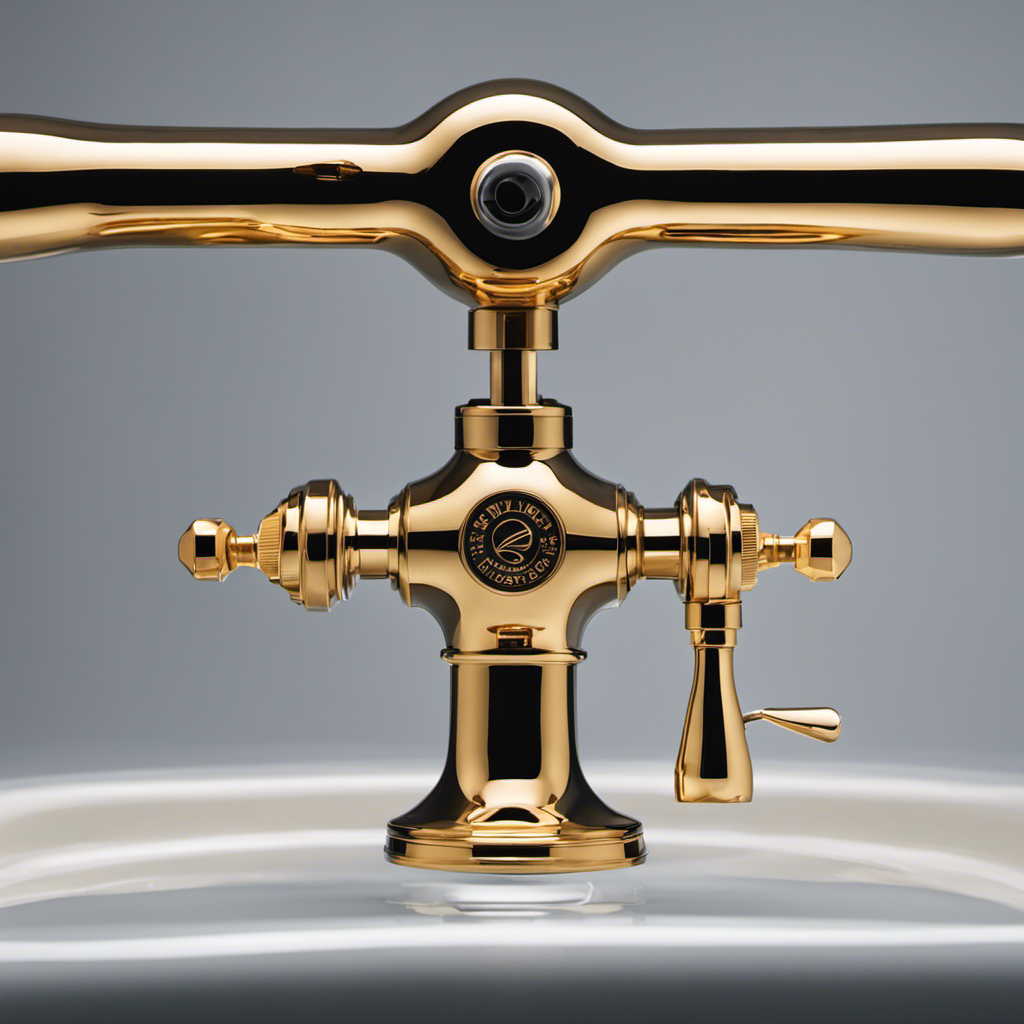Hey there! Ever wondered how many gallons it takes to flush a toilet? Well, look no further because I’ve got all the answers for you.
In this article, I’ll be diving into the world of toilet flushing, exploring standard flush volumes, low-flow toilets, dual-flush systems, and even some water-saving tips.
So, if you’re interested in conserving water and choosing the right toilet for maximum efficiency, stick around and let’s get flushing!
Key Takeaways
- Standard flush volume for toilets is typically 1.6 gallons.
- Low-flow toilets use less water per flush, typically around 1.28 gallons or less.
- Transitioning to low-flow toilets is a practical step towards sustainable water usage.
- Low-flow toilets significantly reduce water consumption and contribute to environmental conservation efforts.
Standard Flush Volume
The standard flush volume for toilets is typically 1.6 gallons. This volume has been established to balance the need for effective waste removal with water conservation efforts. The impact on plumbing is significant, as the higher volume of water helps to clear the pipes and prevent clogs.
Additionally, the larger flush volume ensures that waste is properly transported through the sewer system. However, as water conservation becomes a priority, low-flow toilets have gained popularity. These toilets use less water per flush, typically around 1.28 gallons or even less.
While they still effectively remove waste, they contribute to water conservation efforts and can help reduce water bills. Transitioning to low-flow toilets is a practical step towards sustainable water usage.
Low-Flow Toilets
When it comes to water-saving toilet options, low-flow toilets are a popular choice. These toilets are designed to use less water per flush, which can have a positive environmental impact by conserving water resources.
In addition to being eco-friendly, low-flow toilets can also lead to cost savings in the long run. They can significantly reduce water usage and lower utility bills.
Water-Saving Toilet Options
Did you know that you can save water by using low-flow toilets? These innovative toilet designs are specifically engineered to minimize water usage while still effectively flushing waste.
Here are four water-saving toilet options that can help you conserve water and reduce your environmental footprint:
-
Dual Flush Toilets: These toilets offer two flushing options – a lower volume flush for liquid waste and a higher volume flush for solid waste. This allows you to choose the appropriate amount of water needed for each flush.
-
Pressure-Assisted Toilets: These toilets use compressed air or water to create a powerful flush that effectively clears the bowl with less water. They are particularly useful in commercial settings where high traffic demands efficient flushing.
-
Gravity-Flow Toilets: These toilets use gravity and a well-designed trapway to create a strong siphoning action that efficiently removes waste. They are a popular choice for residential settings as they are cost-effective and require minimal maintenance.
-
Vacuum-Assisted Toilets: These toilets use a vacuum system to enhance the flushing power while minimizing water usage. They are often used in high-rise buildings and boats, where traditional gravity-flow toilets may not be as effective.
By incorporating these water-saving toilet options into your home or business, you can make a significant impact in water conservation efforts while still maintaining optimal performance.
Now, let’s explore the environmental impact of low-flow toilets.
Environmental Impact of Low-Flow Toilets
By choosing low-flow toilets, you can significantly reduce your water consumption and contribute to environmental conservation efforts. Water conservation is crucial for environmental sustainability, and low-flow toilets play a key role in achieving this goal.
These toilets are designed to use less water per flush compared to traditional toilets, usually around 1.28 gallons per flush or even less. This means that every time you use a low-flow toilet, you are saving a significant amount of water. In fact, studies have shown that switching to low-flow toilets can result in water savings of up to 20,000 gallons per year for the average household.
This not only helps to preserve our precious water resources but also reduces the energy required for water treatment and lowers greenhouse gas emissions. With such positive environmental impact, it’s clear that low-flow toilets are a smart choice for water conservation and environmental sustainability.
Now, let’s explore another benefit of low-flow toilets: cost savings.
Cost Savings With Low-Flow Toilets
You can save money on your water bills by choosing a low-flow toilet. Here’s a cost analysis to help you make an informed decision:
-
Reduced water usage: Low-flow toilets use significantly less water per flush, typically around 1.6 gallons compared to the 3.5 to 7 gallons used by older models. This can result in substantial water savings over time.
-
Lower water bills: With reduced water usage, low-flow toilets can lead to cost savings on your monthly water bills. The amount saved will depend on your water rates and usage, but it can add up over the years.
-
Environmental benefits: By conserving water, low-flow toilets contribute to water conservation efforts, helping to preserve this precious resource for future generations.
-
Potential rebates: Many municipalities and water companies offer rebates or incentives for installing low-flow toilets. These programs can further offset the initial cost of purchasing and installing a new toilet.
Considering the cost savings, environmental benefits, and potential rebates, opting for a low-flow toilet is a wise choice for both your wallet and the planet.
Dual-Flush Systems
When it comes to conserving water in the bathroom, dual-flush systems offer several benefits.
These systems allow users to choose between a full flush and a half flush, depending on the waste being disposed of. This not only saves water but also reduces the strain on sewage systems.
Installing and maintaining a dual-flush system is relatively straightforward, and many models are designed to fit standard toilets.
Additionally, the cost of purchasing and installing a dual-flush system is often affordable, making it a practical choice for those looking to save water and reduce their utility bills.
Water-Saving Benefits
Consider how much water you can save by using a low-flow toilet. Water saving technologies have come a long way in recent years, and one of the most effective water conservation efforts is the installation of low-flow toilets.
Here are four benefits of using these water-saving fixtures:
-
Reduced water usage: Low-flow toilets use significantly less water per flush compared to traditional toilets, typically around 1.28 gallons per flush (GPF) or less.
-
Lower water bills: By using less water, low-flow toilets can help you save money on your water bills each month.
-
Environmental impact: With the growing concern for water scarcity and environmental sustainability, using a low-flow toilet can contribute to water conservation efforts and reduce your carbon footprint.
-
Retrofitting options: Low-flow toilets can be easily installed in place of older, less efficient models, making it a convenient option for homeowners looking to upgrade their bathroom fixtures.
By switching to a low-flow toilet, you can save both water and money while contributing to water conservation efforts.
Now, let’s explore the installation and maintenance of these water-saving fixtures.
Installation and Maintenance
Installing and maintaining low-flow toilets is a cost-effective and eco-friendly choice for homeowners. When it comes to the installation process, it is important to hire a professional plumber to ensure proper fitting and functionality. They will first remove the old toilet and then install the new low-flow toilet, which typically involves connecting the water supply line, securing the toilet to the floor, and sealing any gaps.
To keep your low-flow toilet in optimal condition, regular maintenance is key. Avoid using harsh cleaning products that can damage the toilet’s components, and instead opt for mild cleaners. Additionally, be mindful of what you flush down the toilet to prevent clogs and blockages. Regularly check for leaks and make any necessary repairs promptly.
Cost and Affordability?
To save money, you can opt for a low-flow toilet, which is both cost-effective and eco-friendly. Not only will it reduce your water bill, but it will also help conserve water and protect the environment. Here are four reasons why choosing a low-flow toilet is a smart financial decision:
-
Cost savings: Low-flow toilets use significantly less water per flush, which can lead to substantial savings on your water bill over time.
-
Long-term investment: Although low-flow toilets may have a higher upfront cost compared to traditional toilets, their water-saving features make them a worthwhile investment in the long run.
-
Government incentives: Many governments offer incentives, such as rebates or tax credits, for installing low-flow toilets. These incentives can help offset the initial cost and make the switch even more affordable.
-
Environmental impact: By using less water, low-flow toilets contribute to water conservation efforts and reduce strain on water resources. This is not only beneficial for the environment but also for future generations.
Choosing a low-flow toilet is a financially smart and environmentally conscious decision, thanks to its cost effectiveness and the potential government incentives available.
Water-Saving Tips
One of the easiest ways to save water is by using a low-flow showerhead. In addition to this, there are many other water-saving tips that can make a significant impact on our water usage. One such tip is to take advantage of toilet rebates and invest in water-efficient fixtures. These fixtures use less water per flush, reducing the overall water consumption in our homes. To illustrate the potential water savings, consider the following table:
| Fixture | Gallons per Flush |
|---|---|
| Standard Toilet | 3.5-7 |
| Low-Flow Toilet | 1.6-1.28 |
| Dual Flush Toilet | 1.6/0.8 |
Impact of Flush Volume on Water Usage
Switching to a low-flow or dual flush toilet significantly reduces water consumption with each use. Here’s why:
-
Dual Flush: Dual flush toilets offer two flushing options – a half flush for liquid waste and a full flush for solid waste. This allows you to use less water for lighter tasks, saving up to 50% of water per flush.
-
Low-Flow Technology: Low-flow toilets are designed to use less water per flush, typically around 1.28 gallons or less. This is a significant improvement compared to older toilets that could use up to 5 gallons per flush.
-
Impact on Water Conservation: By reducing flush volume, low-flow and dual flush toilets help conserve water resources. This is especially important in areas with water scarcity or drought conditions.
-
Cost Savings: Switching to a low-flow or dual flush toilet can also lead to cost savings on your water bill. With each flush, you’ll be using less water, resulting in lower water consumption and reduced expenses.
Overall, changing to a low-flow or dual flush toilet has a positive impact on water conservation, offering both environmental and financial benefits.
Choosing the Right Toilet for Water Efficiency
When selecting a toilet for water efficiency, it’s essential to consider factors such as flush volume and technology. Toilet design plays a crucial role in water conservation. Modern toilets are designed with advanced features that minimize water usage without compromising on performance. Some toilets use dual-flush technology, allowing users to choose between a full flush for solid waste and a partial flush for liquid waste. This helps reduce water consumption significantly. Additionally, toilets with pressure-assisted flushing systems use pressurized air to clear the bowl efficiently with less water. To compare different toilet models and make an informed decision, refer to the table below, which highlights the flush volume, technology, and water savings of various toilets:
| Toilet Model | Flush Volume (Gallons) | Technology | Water Savings |
|---|---|---|---|
| Model A | 1.28 | Dual-flush | 20% |
| Model B | 1.6 | Pressure-assisted | 35% |
| Model C | 0.8/1.6 | Dual-flush | 30% |
| Model D | 1.28 | Gravity-flush | 25% |
Conclusion
In conclusion, the amount of water needed to flush a toilet depends on various factors such as the type of toilet and its flush volume.
Low-flow toilets and dual-flush systems are excellent choices for conserving water.
By being mindful of our water usage and implementing water-saving tips, we can make a significant impact on our environment.
Just as a drop of water can create ripples that extend far beyond its initial splash, our small efforts to save water can have a profound and lasting effect on our planet.
Choose wisely, and let’s flush with responsibility.










